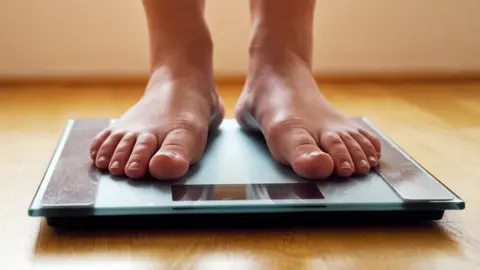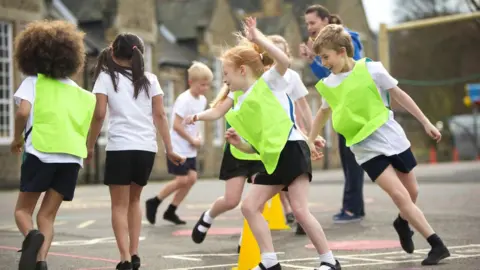Obesity: Have 20 years of policies had any effect?
 Getty Images
Getty ImagesThe prime minister has launched a new policy on obesity in England.
This will not be the first attempt to tackle the problem - at least a dozen policies or white papers have been announced on the topic since 1997.
So, have 20 years of targets and policies had an impact?
Obesity reduction targets
In 2008, a wide-ranging report on obesity aimed to improve diets, increase exercise and form personalised help for tackling the problem.
It also introduced two key targets:
- The UK would be the first major nation to reverse the trend of rising obesity
- To reduce childhood obesity levels to 2000 levels by 2020
The World Health Organization (WHO) has a measurement of obesity that it works out by taking a sample of people from most countries and looking at their body mass index - or BMI - to see if they were a healthy weight for their height.
In 2008, 59.5% of adults in the UK aged over 18 were overweight or obese.
By 2016, the figure was 63.7%. This means that, at that point, the UK had the 30th highest proportion of overweight people of the 191 countries listed.
Looking at England only, the annual Health Survey for England suggests 63% of adults over 16 are overweight or obese.
But it suggests that while obesity rates have increased significantly from 1993, they have stabilised in recent years.
The second target was to reduce childhood obesity.
Using the Health Survey for England we can estimate that the proportion of obese or overweight two to 10-year-olds was the same in 2018 is it was in 2000 - a total of 25%. Over the same period, the proportion of overweight 11 to 15-year-olds increased from 31% to 34%.
All of these results are based on surveys, so there is a margin of error in the data.
In 2008, the Labour government attempted to create a more accurate picture of childhood obesity by measuring almost all children in Reception and Year 6.
This data shows a more sustained increase in childhood obesity than the Health Survey for England.
The Conservative-led coalition produced their own targets in 2011, hoping to see a sustained decrease in child obesity by 2020.
We do not yet have data for 2020, but it doesn't seem there has been a long-term decrease.
Increasing PE in schools
In 2002, the Labour government launched a physical education (PE) policy aimed at linking local schools with specialist sports colleges in their area.
The scheme came with the target to get 85% of kids doing at least two hours a week of PE or sport by 2008.
The government said they surpassed the target - reaching 86% - up from an estimated 25% when the scheme was launched.
 Getty Images
Getty ImagesThe scheme was ended in 2010 by the Conservative-Liberal Democrat coalition government. They also removed the requirement to record how much exercise was done in schools, although they said they expected schools to maintain the current levels.
There is some evidence that the amount of time spent doing PE dropped in the subsequent years - that came from teacher surveys and also figures on the number of hours taught by trained PE teachers.
In 2016, the Conservatives announced that - using money from the sugar tax - there would be an increase in sports or PE funding.
In the same year, their childhood obesity plan also recommended that children should do at least an hour of exercise a day, with at least half an hour in school and half an hour supported by parents and carers outside of school.
For 2018-19, it was estimated that just under half of children met that target.
Eating your 5-a-day
The 5-a-day slogan became government policy in 2003.
Since then, the proportion of adults eating five portions of fruit and vegetables a day has increased from about 24% to about 28%, according to the NHS's Health Survey for England.
On average, adults ate 3.7 portions of fruit and vegetables a day compared with 3.4 in 2003.
However, the proportion eating fewer than two portions a day has remained roughly the same at 27%.
Reducing obesity inequality
The Conservative government's child obesity strategy opened by saying "the burden is falling hardest on those children from low-income backgrounds".
Over the past decade the gap in childhood obesity levels between the poorest and wealthiest had increased from 8.5 percentage points to 13.5 percentage points.
No specific targets were given.
Across England, obesity rates vary considerably - ranging from over 75% of all adults in Rotherham, Hartlepool and Thurrock to under 45% in Camden and the City of London.
Sugar tax
The UK introduced a tax on drinks that were high in sugar in April 2018. Companies have to pay:
- 24p per litre of drink if it contains more than 8g of sugar per 100ml
- 18p per litre of drink if it contains between 5 and 8g of sugar per 100ml
The policy was declared a success before it was even launched as manufacturers changed the recipes of their drinks to avoid paying the tax.
Between 2015 and 2018 the total quantity of soft drinks sold containing at least 5g of sugar per 100ml fell 50% while sales of drinks containing less than 5g per 100ml rose by 40%.
The amount of tax paid in each quarter since the levy was launched has been higher than it was in the first, suggesting the reductions in sugary drinks being sold have not continued.



Did you take part in a previous scheme where doctors prescribed exercise, such as vouchers for free gym sessions or similar? Did it help you? Email [email protected].
Please include a contact number if you are willing to speak to a BBC journalist. You can also contact us in the following ways:
- WhatsApp: +44 7756 165803
- Tweet: @BBC_HaveYourSay
- Please read our terms & conditions and privacy policy
